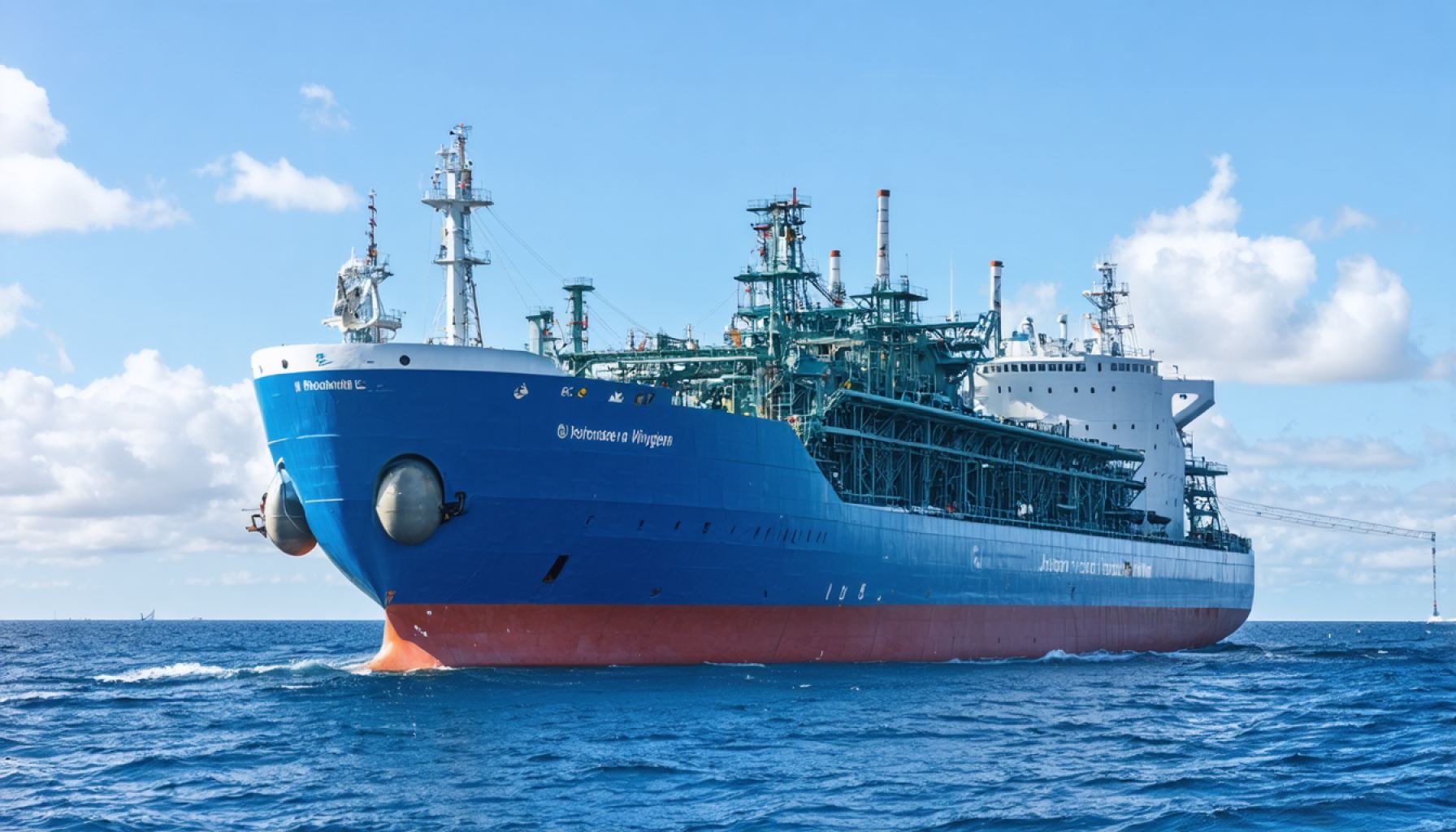- Introduction of the world’s first floating ammonia-to-hydrogen cracker, crafted by Höegh Evi and Wärtsilä Gas Solutions, signifies a major advancement in green technology.
- Launched on April 24, 2025, the structure aims to revolutionize energy imports by transforming ammonia into hydrogen, boasting an annual capacity of 210,000 tonnes.
- The scalable structure functions as part of hybrid floating storage and regasification units or as an independent hydrogen production unit.
- Development was backed by a €5.9 million investment from the Norwegian government and involved collaboration with various research institutes.
- Höegh Evi plans to establish a European network of hydrogen terminals, contributing to the EU’s goal of importing 10 million tonnes of renewable hydrogen annually by 2030.
- This innovation marks a new chapter in Europe’s energy landscape, providing a reliable source of clean energy.
Beneath the cold, rolling waves of innovation lies a triumph in green technology, as the world’s first floating ammonia-to-hydrogen cracker makes its debut. Crafted through the tenacious partnership between marine energy mavens Höegh Evi and Wärtsilä Gas Solutions, this monumental development marks a turning point in sustainable energy.
Birthed in Norway’s forward-thinking green platform program in April 2023, this maritime marvel reached its official launch two years later on April 24, 2025. Designed to revolutionize how the world approaches energy imports, the technology brings the alchemy of ammonia cracking to the industrial fore. With an annual send-out capacity of up to 210,000 tonnes of hydrogen, this floating sentinel of the seas promises to reshape the path to a cleaner energy horizon.
Housing itself comfortably between hybrid floating storage and regasification units, or as a lone aquatic fortress of hydrogen production, the structure boasts scalability. Ammonia, stored in vats as large as 120,000 cubic meters, undergoes a transformation into hydrogen—a simpler, cleaner energy currency fit for global commerce.
The groundwork for this innovation was laid at the Sustainable Energy’s Catapult Center in Stord, where a coalition of experts from the Institute for Energy Technology, University of South-East Norway, Sustainable Energy, and BASF SE fused their expertise. Their endeavor, supported by the Norwegian government’s €5.9 million investment, underscores a communal pledge to the hydrogen economy.
For Erik Nyheim, the CEO of Höegh Evi, this development encapsulates a vision of providing Europe with a reliable pipeline of green energy. The floating terminals and cracking technology unlock a new dimension of global value chains, promising a trustworthy supply to feed Europe’s industrial appetite for clean energy.
Moving forward, Höegh Evi, armed with this avant-garde technology, is pioneering a network of hydrogen terminals across Europe. These projects, slated to commence operations before 2030, align with the EU’s audacious REPower strategy. The strategy sets its sights on importing 10 million tonnes of renewable hydrogen annually by 2030—a goal now within reach thanks to this floating cracker’s ingenuity.
This innovative structure embodies more than just a solution; it heralds a new chapter in Europe’s energy story. As the winds of change fill its sails, this floating marvel propels us toward a horizon where cleaner energy flows as steadily as the tides themselves.
Revolutionizing Renewable Energy: The World’s First Floating Ammonia-to-Hydrogen Cracker
Overview
The world’s first floating ammonia-to-hydrogen cracker represents a significant leap forward in sustainable energy, created through the collaboration of Höegh Evi and Wärtsilä Gas Solutions. This pioneering project, initiated under Norway’s green platform program, has laid the groundwork for revolutionizing global energy import strategies and scaling up renewable energy use.
How a Floating Ammonia-to-Hydrogen Cracker Works
1. Ammonia Storage: The process begins with storing large quantities of ammonia, up to 120,000 cubic meters, onboard the floating facility.
2. Ammonia Cracking: Utilizing cutting-edge technology, ammonia is cracked into hydrogen—a cleaner and more versatile energy source.
3. Hydrogen Production: The floating cracker can produce an impressive 210,000 tonnes of hydrogen annually, providing a significant boost to sustainable energy supply chains.
Market Forecasts & Industry Trends
– Growing Demand: As the EU’s REPower strategy aims to import 10 million tonnes of renewable hydrogen annually by 2030, the demand for technologies like floating crackers is set to rise.
– Expansion Plans: Höegh Evi plans to develop a network of hydrogen terminals across Europe before 2030, positioning themselves as a leader in the renewable hydrogen market.
Real-World Use Cases
– Decarbonizing Industry: This technology has the potential to decarbonize industries heavily reliant on fossil fuels by providing a steady supply of clean hydrogen.
– Energy Security: By decentralizing hydrogen production and expanding infrastructure, countries can enhance their energy security and reduce reliance on non-renewable energy sources.
Pros & Cons Overview
Pros:
– Environmental Impact: Reduces carbon footprint by transitioning from ammonia to hydrogen as a cleaner energy carrier.
– Scalability: Adaptable in size and capable of serving multiple markets, making it a versatile solution for different regions.
Cons:
– High Initial Costs: The technological advancements and infrastructure associated with floating crackers require significant investment.
– Technical Challenges: Ensuring operational efficiency and safety in maritime environments presents unique challenges.
Controversies & Limitations
– Regulatory Hurdles: Navigating international maritime laws and environmental regulations could pose challenges.
– Technical Reliability: Long-term reliability and maintenance in challenging marine conditions remain areas to monitor closely.
Insights & Predictions
– Technological Advancements: As technology progresses, we can expect further improvements in efficiency and design, making these floating crackers even more economically viable.
– Increased Adoption: With growing environmental concerns, more countries and companies may invest in this groundbreaking technology.
Quick Tips for Industry Stakeholders
1. Invest in Research: Continued investment in research can drive efficiency improvements and cost reductions.
2. Regulatory Collaboration: Engage with regulatory bodies early to ensure compliance and smooth operational rollout.
3. Public-Private Partnerships: Foster partnerships to leverage resources and accelerate the adoption of innovative energy solutions.
For more exciting renewable energy innovations, visit the Höegh Evi and Wärtsilä websites.
